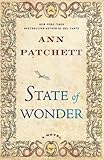[amazon_link id=”0062049801″ target=”_blank” container=”” container_class=”” ] [/amazon_link]Title : State of Wonder
[/amazon_link]Title : State of Wonder
Author : Ann Patchett
Genre : Contemporary
Publisher : HarperCollins
Pages : 353
Rating : 4.5/5
Ann Patchett’s most recent novel has as it’s stoic heroine Marina Singh, an Indian-American woman. A doctor turned researcher Dr. Singh, the daughter of an American mother and an Indian father who returned home to India after getting his doctoral degree, works for pharmaceutical company Vogel. Vogel is sponsoring research in the Amazon for a miraculous drug which will allow women to remain fertile until late age. Dr. Annick Swenson, who is spear-heading that research is a recalcitrant, close-lipped woman, who does not give Vogel much information, except to tell it that she needs more time to develop the drug. In desperation, the CEO Mr. Fox sends Marina’s research partner Dr. Anders Eckman to the Amazon to locate Dr. Swenson and get her to hasten up the drug development process.
Dr. Eckman dies in the Amazon, and word comes back to Minnesota of his death, two weeks later, via a curtly-worded blue aerogramme. Marina is then persuaded to go to the Amazon ostensibly to retrieve Dr. Eckman’s body and belongings for his grieving widow and family. In Brazil, Marina languishes for a while in Manaus at the mercy of the Bovenders, a young couple Dr. Swenson has employed to fend off Vogel emissaries. When she does meet Dr. Swenson, the eminent researcher attempts to thwart Marina’s questions and encourages her to return home. But Marina is steadfast and accompanies Dr. Swenson to her research lab in the deep jungles of the Amazon where she is studying the women of the Lakashi tribe. The location is remote, and having lost her phone en-route, Marina is cut-off from her world and it’s familiar connections and unprepared for what she will find.
There are two main characters in this book – Marina and Dr. Swenson. Swenson is an enigmatical figure, cruel yet compassionate, firm in her own interpretation of justice and morality. Marina, ostensibly the weaker of the two, has her own demons to deal with, since she has once known Dr. Swenson well, although Dr. Swenson may not remember her. Besides that very conflict-causing fact, we also know that Marina longs for her missing father, and is caught between her Indian and American identities:
Her skin was all cream and light in comparison to her father’s and very dark when she held her wrist against her mother’s. She had her father’s round, black eyes and heavy lashes, his black hair and angular frame. Seeing her father gave her the ability to see herself, the comfort of physical recognition after a life spent among her mother’s people, all those translucent cousins who looked at her like she was a llama who had wandered into their holiday dinner. The checkers in the grocery store, the children at school, the doctors and the bus drivers all asked her where she was from. There was no point in saying, Right here, Minneapolis, though it was in fact the case. Instead she told them India, and even that they didn’t always understand.
I will admit that Marina’s character is the reason I picked up this book, ahead of all those books which cram my to-be-read pile. It doesn’t hurt that this comes much recommended by friends. And truly, “State of Wonder” is a luminous novel, and it gets it’s beauty from the wonderful prose – I could quote from every page – and Ms. Patchett’s skilled telling of the slowly unfolding, but momentous drama. I could summarize this book in a few short sentences, but that does it little justice. To fully appreciate this novel, one must read along with every eventful turn, to learn about each character – their thoughts and their motivations and the little nuanced swishes that very few authors can capture in this degree of exquisite detail :
Dr. Swenson put her hands on her thighs and pushed up but she did not stand. She was thicker around the middle than she had been in Baltimore and the weight and the long time sitting seemed to keep her tied to her case of hash. Dr. Swenson, so far as Marina could calculate would be in the neighborhood of seventy. It was possible at this point that even Dr. Swenson was tired. Marina stood up and extended her hand.
This is the rarest of the rare – a novel that I’m tempted to award a whole, perfect 5 star rating. The only reason I don’t do it is the slightly disappointing (and heart-breaking) ending. Regardless, this is a fabulous, fabulous book. If you read one book this year, let it be this one.

 Checking in this Sunday to keep an up-to-date count of all the books read for my Reading Challenges. I keep forgetting to link the reviews up at the host’s site, so I’ll catch them up here. So far I have read the following :
Checking in this Sunday to keep an up-to-date count of all the books read for my Reading Challenges. I keep forgetting to link the reviews up at the host’s site, so I’ll catch them up here. So far I have read the following :
 [/amazon_link]Title : The House at Tyneford
[/amazon_link]Title : The House at Tyneford

 [/amazon_link]Title : State of Wonder
[/amazon_link]Title : State of Wonder [/amazon_link]Title : Accidents of Providence
[/amazon_link]Title : Accidents of Providence
 [/amazon_link]Title : Midnight in Austenland
[/amazon_link]Title : Midnight in Austenland
